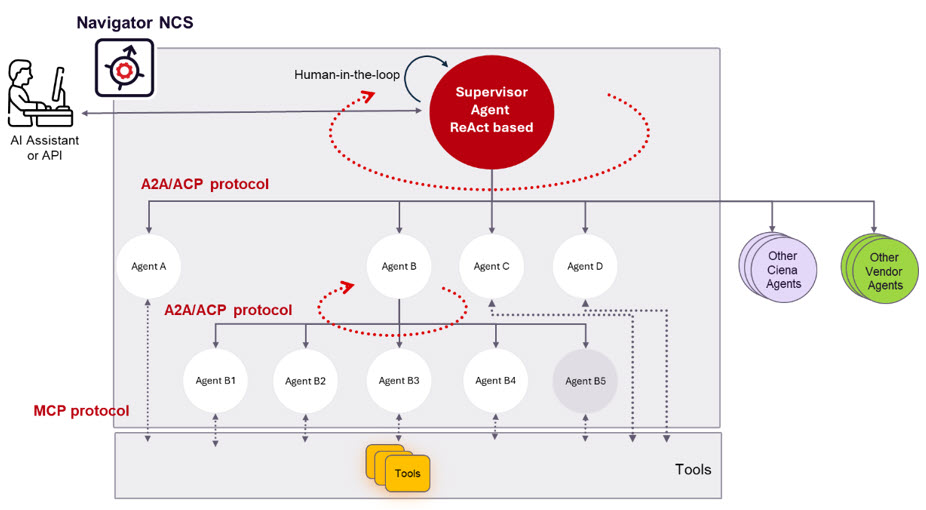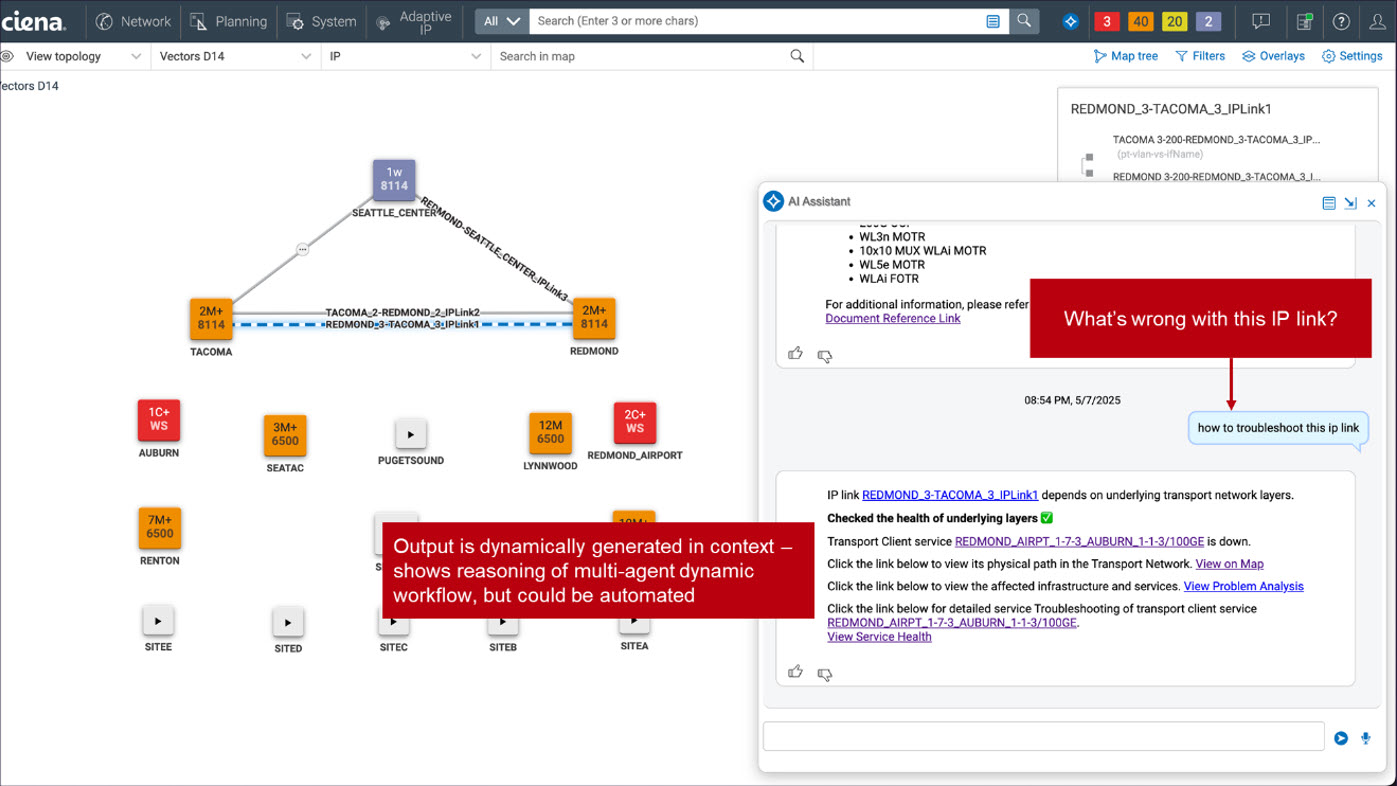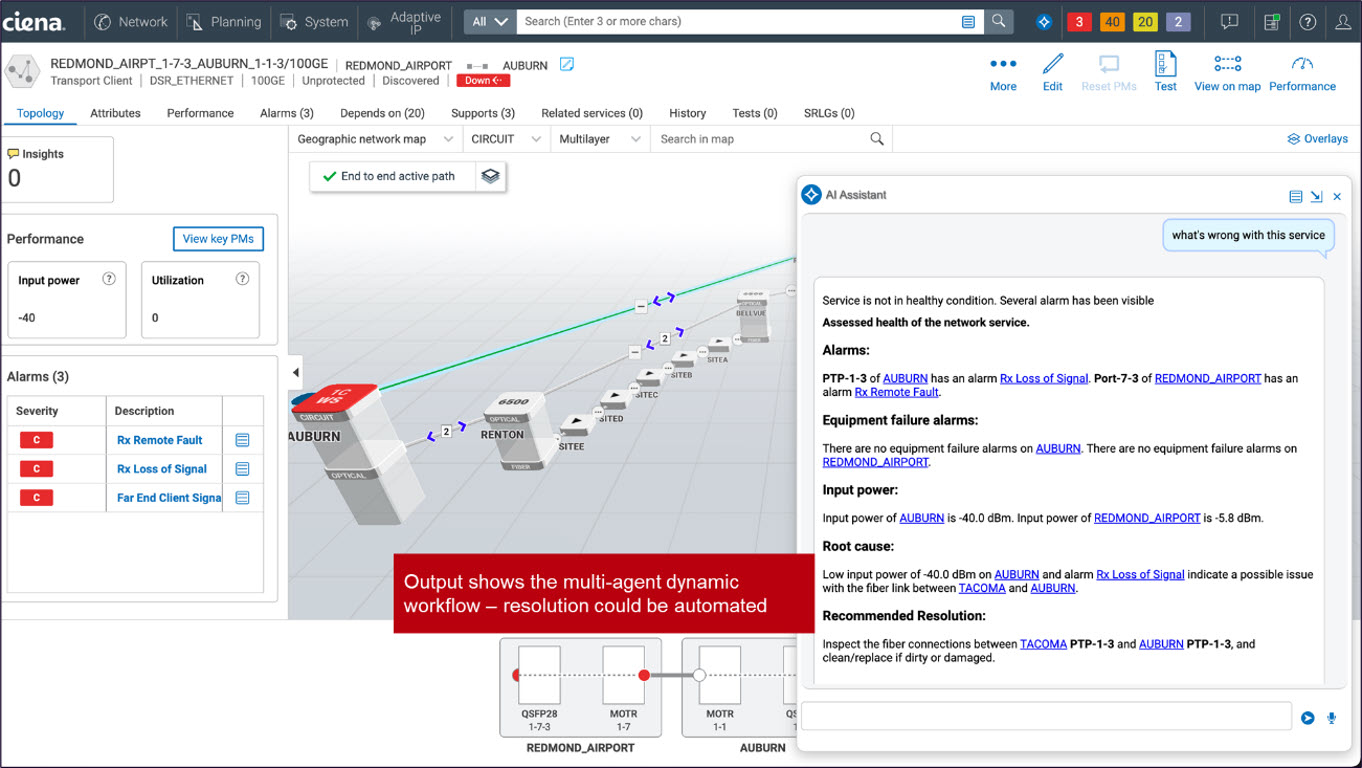Reasoning is the third frontier of the AI era, following perception AI and generative AI (GenAI), with its proliferation of Large Language Models (LLMs). Now, AI agents can autonomously reason, make decisions, and act. How is this agentic AI technology applied to network operations? In this blog, Marie Fiala illustrates how AI agents can help tackle a key operational pain point: network troubleshooting.
We are now in the third phase of the AI era, coined ‘reasoning AI’. We are forging ahead and applying the latest-and-greatest AI technologies to various aspects of network operations – commonly known as AIOps. Imagine being able to ‘talk’ to your network as if it were an expert colleague. You could ask questions about performance bottlenecks, request optimization suggestions, or even direct it to resolve issues autonomously. This is the essence of AIOps, where AI agents act as virtual network engineers to which you can ask questions about your IP/Optical network.
Ciena’s Navigator Network Control Suite (Navigator NCS) embodies this vision by integrating AI-driven capabilities, enabling operators to make informed decisions faster while minimizing manual intervention. The objective is to deliver operational benefits to Navigator NCS customers across the entire lifecycle of single-layer or multi-layer networks, which includes network planning, assurance, predictive analysis, optimization, and automation. By leveraging both historical and real-time data from the IP/Optical network, Navigator NCS ensures enhanced efficiency and intelligent decision-making throughout the network lifecycle.
But where to start? In our discussions with customers, they’ve cited network assurance and troubleshooting as the most critical and time-consuming operational tasks, which they’d like to accelerate and automate with the use of AI. In my earlier blog, I introduced the Navigator NCS agentic AI framework, with a supervisor agent (also known as an orchestration agent) coordinating the results from multiple autonomous AI agents, to produce a dynamic workflow that delivers a tailored response to a user or machine. Each agent performs reasoning, with the help of GenAI LLM, and acting (ReAct). In fact, the framework is flexible in that an AI agent can interface with other ‘subtended’ agents – using protocols such as Agent2Agent (A2A) or Agent Communication Protocol (ACP) – and leverage tools – via Model Context Protocol (MCP) – in order to perform its reasoning and acting. This framework is depicted in Figure 1, below.
 Figure 1. Ciena’s Navigator agentic AI framework
Figure 1. Ciena’s Navigator agentic AI framework
Network assurance can be divided into two categories: reactive assurance – tackling network issues which have already happened – and proactive assurance – addressing issues which may happen in the future. In the context of reactive network assurance, Navigator’s agentic AI framework explores different potential root causes, evaluates the outcomes of that exploration, and iterates through multiple potential decisions to deliver the solution.
In the example below (Figure 2), the user has highlighted the IP link that is down and asks for assistance. Multiple AI agents then sprung into action to process the natural language query and dynamically analyze the issue within the user’s specific context. The network controller agent used the ReAct mechanism to investigate various reasons for this issue and finally identified a root fault in the optical transport underlay and presented the user its decision-making steps.
 Figure 2. Ciena’s Navigator AI Assistant provides an easy interface help troubleshoot network issues
Figure 2. Ciena’s Navigator AI Assistant provides an easy interface help troubleshoot network issues
Navigator NCS identified the root cause of the issue, by analyzing and visualizing the data associated with the underlying optical transport client service and presented the recommended resolution (Figure 3). The reasoning and acting steps can be presented to the user – as shown here – or provided to another agent or automated altogether.

Figure 3. Ciena’s agentic AI workflow analyzes the issue and presents a recommendation quickly.
Matching deployment strategy to operational priorities
To realize the agentic AI solution, each agent needs to connect to GenAI LLM(s) to perform its reasoning. As a result, another question that is top-of-mind for customers is which deployment model to use. An on-premise deployment provides maximum control over security and privacy, making it ideal for industries with stringent compliance requirements. However, it lacks the scalability of the cloud and requires significant investment in hardware and maintenance. In contrast, a public cloud deployment offers elastic compute resources, enabling the framework to scale dynamically based on workload demands. This model is cost-effective and agile but raises concerns about data privacy and shared infrastructure security. A private cloud deployment strikes a balance, offering the scalability and flexibility of the cloud while maintaining dedicated infrastructure for enhanced privacy and security so that sensitive data stays within controlled environments.
How about a hybrid deployment model? Customers could utilize the full power of the cloud as their primary operating model (private or public cloud) but have an on-prem installation as a backup in the event that they lose connectivity to the cloud. This hybrid approach would ensure that operators could always see and monitor their network, and perform essential tasks, thus derisking cloud deployments. Choosing the right deployment model depends on the organization's priorities regarding security, privacy, cost efficiency, and operational scalability.
There are many possibilities for deploying and exploring how to make AI agents work for you in the network operations arena. These autonomous agents can manage complex network operations tasks without constant user input, enabling them to reason accurately and act quickly. Above, I’ve outlined how this works for reactive network assurance. Now is the time to identify your specific operational use cases and explore how Ciena’s Navigator NCS AIOps can accelerate and automate them. Discover how much of an impact AI can have on your network operations!






